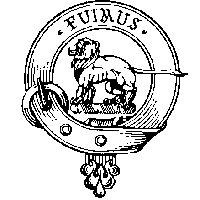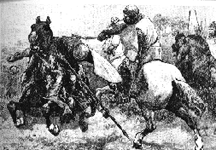
|
Bruces on the Net House of Bruce Discussion Area House of Bruce Contacts |

|
Bruces on the Net House of Bruce Discussion Area House of Bruce Contacts |

 William the Lion confirmed to the son the grant of the lands of Annandale made to his father by David I. Robert, fourth Lord of Annandale, laid the foundation of the royal house of Bruce when he married Isobel, niece of William the Lion. She also brought extensive estates, both in Scotland and England. Princess Isobel's son, another Robert, known as 'the competitor', was at the time named heir to the Scottish crown. However, his claim was challenged by the birth of a son to the daughter of his wife's elder sister, who was married to John Balliol. On the death of Alexander III in 1286 there commenced the contest for the succession to the Crown between Bruce and Balliol. The death of the child heir to the throne,, Margaret, the maid of Norway, in 1290, opened the competition for the succession once more, and to avoid a civil war, the rival claimants asked Edward I of England to act as arbiter. In 1292 Edward found in favour of John Balliol. But Edward was not content to advise on the selection of the new monarch, and asserted a right of overlordship in Scottish affairs. Balliol attempted armed resistance but was decisively defeated at the Battle of Dunbar in 1296. His defeat left the leadership of Scotland in the hands either of the powerful Comyn family or the Bruces. Robert the Bruce met John Comyn in February 1306 in the Church of the Minorite Friars at Dumfries. Bruce stabbed his rival in the heart, and his companions dispatched the rest of the Comyn party. Within weeks Robert was crowned King and began a long, hard campaign to make his title a reality, culminating in the Battle of Bannockburn in 1314. He set about rebuilding the shattered nation and it is a considerable tribute to his leadership and abilities that he substantially achieved his objectives. In 1370 the first Stewart monarch succeeded to the throne by right of descent from Marjory, Bruce's daughter.
William the Lion confirmed to the son the grant of the lands of Annandale made to his father by David I. Robert, fourth Lord of Annandale, laid the foundation of the royal house of Bruce when he married Isobel, niece of William the Lion. She also brought extensive estates, both in Scotland and England. Princess Isobel's son, another Robert, known as 'the competitor', was at the time named heir to the Scottish crown. However, his claim was challenged by the birth of a son to the daughter of his wife's elder sister, who was married to John Balliol. On the death of Alexander III in 1286 there commenced the contest for the succession to the Crown between Bruce and Balliol. The death of the child heir to the throne,, Margaret, the maid of Norway, in 1290, opened the competition for the succession once more, and to avoid a civil war, the rival claimants asked Edward I of England to act as arbiter. In 1292 Edward found in favour of John Balliol. But Edward was not content to advise on the selection of the new monarch, and asserted a right of overlordship in Scottish affairs. Balliol attempted armed resistance but was decisively defeated at the Battle of Dunbar in 1296. His defeat left the leadership of Scotland in the hands either of the powerful Comyn family or the Bruces. Robert the Bruce met John Comyn in February 1306 in the Church of the Minorite Friars at Dumfries. Bruce stabbed his rival in the heart, and his companions dispatched the rest of the Comyn party. Within weeks Robert was crowned King and began a long, hard campaign to make his title a reality, culminating in the Battle of Bannockburn in 1314. He set about rebuilding the shattered nation and it is a considerable tribute to his leadership and abilities that he substantially achieved his objectives. In 1370 the first Stewart monarch succeeded to the throne by right of descent from Marjory, Bruce's daughter.
Thomas Bruce, who later claimed close kinship with the royal house, organised with Robert the Steward (later Robert II) a rising in Kyle against the English in 1334. He received in recompense part of the Crown lands of Clackmannan.
Sir Edward Bruce was made commendator of Kinloss Abbey and appointed judge in 1597. In 1601 he was appointed a Lord of Parliament with the title of "Lord Kinloss". He accompanied JamesVI to claim his english throne in 1603 and was subsequently appointed to English judicial office as Master of the Rolls. In May 1608 he was granted a barony as Lord Bruce of Kinloss. His son, Thomas, was created first earl of Elgin in 1633. The fourth Earl died without a male heir and the title passed to a descendant of Sir George Bruce of Carnock, this branch of the family had already been created Earls of Kincardine in 1647, and thus two titles were united.
The seventh Earl of Elgin was the famous diplomat who spent much of his fortune ressuing the marbles of the Parthenon which were at that time falling into utter ruin. His son was an eminent diplomat and Governor General of Canada. He led two important missions to the Emperor of China. He was Viceroy of India, a post also held by the ninth Earl of Elgin from 1894-1899.
The present Chief- the eleventh Earl of Elgin and fifteenth of Kincardine- is prominent in Scottish public affairs and is convener of the Standing Council of Scottish Chiefs.






